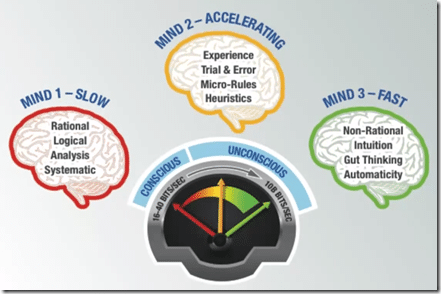 I was reading a book on numerics and statistics this morning and the author quoted Kahneman (as fact) as if humans make decisions in two speeds. According to Kahneman’s binary ‘theory’ humans only make decisions at two speeds – slow/rational/analytical and fast/automatic. This is a myth, there is plenty of evidence for in-between notions of a developmental pace in decision making. Yet binary thinking is so attractive, especially to Safety.
I was reading a book on numerics and statistics this morning and the author quoted Kahneman (as fact) as if humans make decisions in two speeds. According to Kahneman’s binary ‘theory’ humans only make decisions at two speeds – slow/rational/analytical and fast/automatic. This is a myth, there is plenty of evidence for in-between notions of a developmental pace in decision making. Yet binary thinking is so attractive, especially to Safety.
Of course, the notion of fast and slow is contradicted by the very principle of learning.
Think back to when you learned to ride a bike, and then to be come competent. This takes more than a year.
Think about the acquisition of language to competence, that takes 12 years or more.
Think about developing competence in anything to the point where it becomes a heuristic. For example, driving a car, learning use of a computer, spreadsheet, developing mathematical skills, preparation for a career, qualification. This all takes years. Indeed, some still don’t learn wisdom after 50 years.
The concept of fast and slow is contradicted by all the evidence in cognitive neuroscience. But hey, don’t let neuroscience get in the way of belief in a myth (https://safetyrisk.net/the-myth-of-neuroscience-safety/).
This is why SPoR advocates One Brain Three Minds (1B3M) and a dialectic between fast and slow. Such an understanding changes the whole way one understands how people tackle risk and helps move away from binary judgmentalism that blames people for learning or being in a process of learning.
There are plenty of critics of Kahneman’s theory but when you are in the groove of binary symbology (mythology), you are on your way to an International best seller and, we all know that if it’s an International best seller, it must be true.



Brian Darlington says
Hi Rob, so true!! About a year ago I read the book by Kahneman “Fast and Slow” and it was clear that he ignores the intermediate mind. Understanding 1B3M also allows us to understand that we move constantly between the three. Good to understand that the author had a bias and not just to accept what is read.
Rob Long says
Brian, behaviourist economics is quite limited in how it views personhood and hence Kahneman’s perspective.
The important thing is to remember that learning anything is gradual, not fast and slow and that it is continuous. The idea that competence is fast and slow is nonsense. This means that when we observe and investigate events we know that all involved are at different stages of learning.
Mark Taylor says
The experience of learning and memory has more dimensions than we notice, some of which can have an impact on retention. Adding music, light, background colour can be beneficial because they become annoyingly ephemeral in our subconscious.
We need to make safety procedures more contextual, so that they become conscious, visible and part of a scene, an autobiographical memory. The science tells us that, at least when it comes to retention of new facts, the subconscious ones are valuable, too.
The oldest learning technique in memory science is also one of the most powerful, reliable, and easy to use. Psychologists have known about it for more than a hundred years and proven that it works to deepen the learning of subject areas or skills that call for rote memorization, like foreign vocabulary, scientific terms and concepts, equations, or musical scales. Yet mainstream education has largely ignored it and in safety circles we ignore it by trying to cram everything into a twenty minute Toolbox Talk at the start of the day.
As a child you might recall your parent offering you advice when studying for an exam saying “Don’t you think it would be better to study for a little bit tonight and a little bit tomorrow, rather than trying to learn everything at once?”
The technique is called distributed learning or, more commonly, the spacing effect. People learn at least as much, and retain it much longer, when they distribute—or “space”—their study time than when they concentrate it. Mom’s right, it is better to do a little today and a little tomorrow rather than everything at once. Not just better, a lot better. Distributed learning, in certain situations, can double the amount we remember later on.
Rob Long says
Thanks Mark. Jung didn’t use the word ‘subconscious’ because Freud made it a negative. I never use the term because our unconscious is neither evil or good.
The addition of embodied experience to memory infuses body and mirror neuron memory into play. Try reading Fuchs and Damasio.